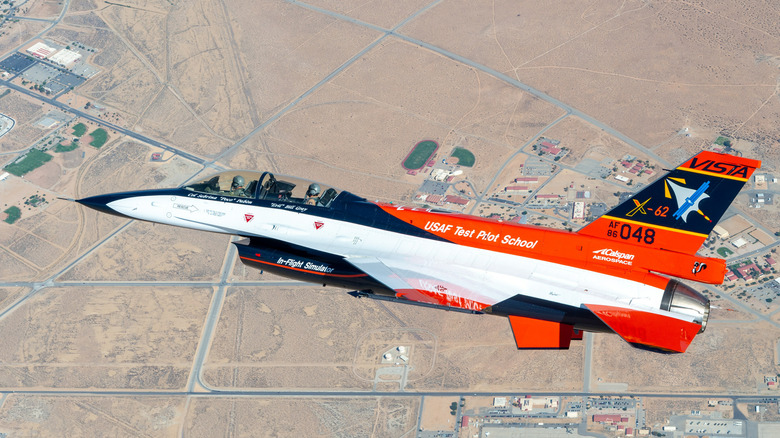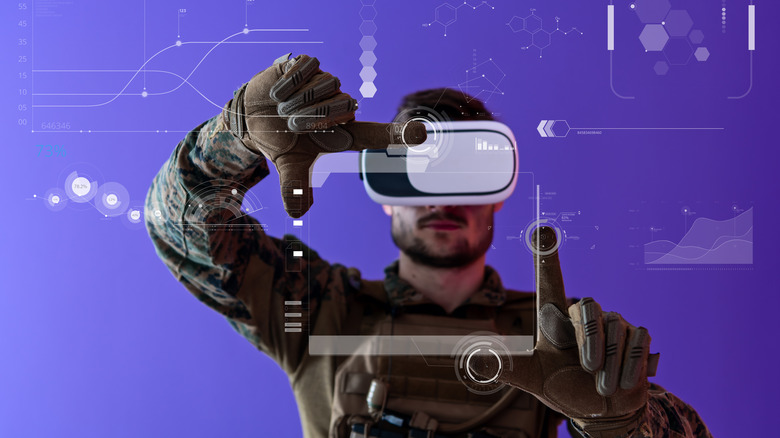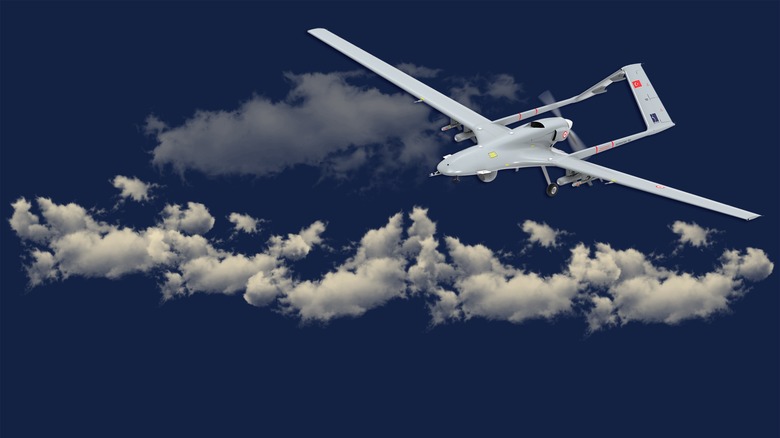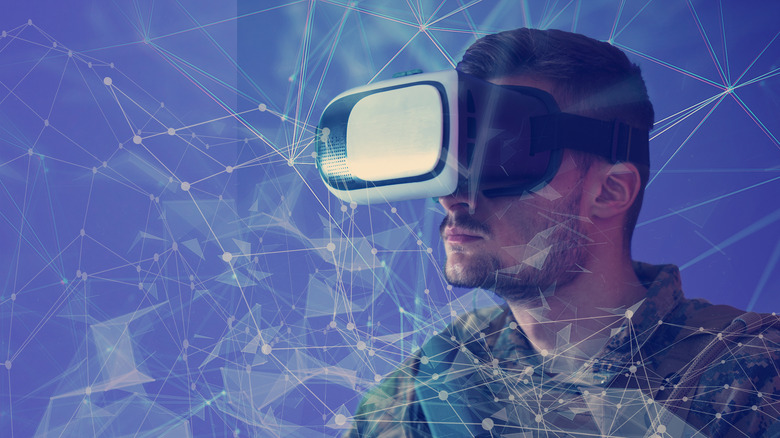The Future Of Fighter Jets: AI And Unmanned Aerial Combat
While the threat of nuclear warfare has loomed for decades, a different song is being sung in the age of technology. These days, the tides have turned, and technology like artificial intelligence (AI) is beginning to change the rules of war. For years, world militaries have been divided on how AI should be used on and off the battlefield. After all, it poses complex questions regarding what aspects of decision-making should be outsourced and what kind of training is necessary to equip soldiers to use it both effectively and ethically.
With countries racing to develop military applications of AI, it's only a matter of time before it becomes even more of a decisive factor in the battlefield. Among the many ways technology is transforming the U.S. military, AI has been a growing boon for fighters looking to optimize their performance, especially in the skies. In June 2023, Boeing announced the development of MQ-28, its "Ghost Bat" Drone, which uses advanced AI to support existing fighter jet fleets by tracking both opposing and allied aircraft. But, did you know that just a few months earlier, the U.S. Air Force already had a successful autonomous flight with a fighter jet?
In 2022, a modified F-16 fighter jet using AI took off from Edwards Air Force Base in California. During its test flight, the fighter jet, codenamed VISTA X-62A, displayed advanced fighter maneuver drills. After returning to base, the VISTA became the first tactical aircraft to be successfully piloted with AI in history.
AI and fighter jet integration
In 2019, the U.S. Air Force launched the "Skyborg" program, which was instated to develop an AI-enabled system to control unmanned aircraft. Just a year later, it demonstrated its compatibility with aircraft from varying contractors through its Autonomous Core System.
In its 2023 budget request of over $100 million, the U.S. Air Force indicated its plans to further its research into the Research, Development, Test, and Engineering program called Autonomous Collaborative Platforms (ACP). According to Air & Space Forces, assessments by the Air Force, Mitchell Institute, and other experts suggest ACPs provide a potentially lower cost to providing sufficient airpower in the Pacific.
In a statement to Wired, M. Christopher Cotting, director of research at the Air Force Test Pilot School said, "We're not trying to replace pilots, we're trying to augment them, give them an extra tool." Through AI, Cutting shares added "a first lieutenant with 100 hours of experience in the cockpit could artificially gain the same edge as a much higher-ranking officer with 1,000 hours of flight experience."
Knowing the role of AI in military simulation is becoming more common, we'll also likely see a new breed of soldiers, who are primed to both work with AI. In partnership with the U.S. Air Force, MIT researchers even instated AI training programs for military personnel in 2023.
The advantages of unmanned combat
Aside from jet fighters, there have been other developments with the use of AI, particularly in military vehicles. In 2022, the Israel Ministry of Defense (MOD) announced its plans to begin testing a medium-sized, robotic combat vehicle (MRCV), called the Robotic Autonomous Sense and Strike (ROBUST), which seeks targets, handles tracking and firing, etc.
A year later, Ukraine's devDROID revealed its AI-controlled turrets, designed to rise up from trenches while aiming at a target and calculating ballistics, but still requiring a human operator to confirm the target. Playing a huge role in its infantry strategy against Russia, the this combat module already stands to revolutionize trench warfare as we know it.
In the water, the U.S. the U.K., and Australian Navies began testing AI in tracking Chinese submarines in the Pacific in December 2023. As part of its technology-sharing agreement, the Aukus Pillar II, AI algorithms will be used to process sonar data from multiple systems, including submarines and surface vessels.
From the skies to the seas, the growing trend of unmanned AI-integrated military craft opens up several possibilities in terms of cost savings, precision targeting, and reduced casualties on the battlefield. By reducing the human risk element, operators can ideally make better decisions during aerial combat. But is there a cost?
The risks of AI-integrated fighter jets
In such a volatile environment, it's no wonder that countries are fighting to establish internal norms, functional roles, and infrastructure to make the most out of the advantages of unmanned combat. In many ways, this push towards AI-powered unmanned combat in fighter jets also means evolving strategies for securing autonomous systems, as well as learning to defend against them as well. The growing dependence on artificial intelligence poses new risks for military units, especially when mitigating ongoing and prospective cybersecurity threats.
Among the shortfalls of the U.S. Air Force Weapon Systems, the Rand Corporation shares in its research brief that control and accountability for military system cybersecurity is often spread over several organizations. Because of this, it cites that it can lead to challenges in decision-making and accountability. However, due to the unpredictability of cybersecurity as a whole, it's critical to understand that the United States isn't the only country that has this problem.
Additionally, it's important to understand that although algorithms can streamline decision-making processes, they also lack the human element of flexibility. In some cases, split-second decision-making based on instinct is an important aspect of the preservation of life.
Because of the transnational nature of artificial intelligence, understanding its challenges as well as opportunities is essential to drafting regulation, before its capabilities become out of hand. In tandem with other emerging technologies, such as biotechnology, robotics, and quantum computing, we've barely scratched the surface of military applications in AI, including its consequences.
The role of regulation in AI warfare
According to the Centre for International Governance Innovation, national defense and security hold without a doubt "the most complex governance challenges surrounding artificial intelligence."
In October 2023, U.S. President Joe Biden issued an Executive Order, aiming to establish safe, secure, and trustworthy AI standards. Among its chief requirements was for developers to share safety test results. In terms of military applications, the EO also mandated the development of a National Security Memorandum by the National Security Council and the White House Chief of Staff, to ensure the safety, ethics, and effectiveness of using AI in their missions. Aside from this, it also directs actions to counter adversaries' military use of AI, which means it's still an ongoing discussion.
On the other hand, the European Union agreed on landmark legislation in AI regulation in December 2023. Initially proposed in 2021, Al Jazeera claims that it was delayed but reprioritized after the launch and subsequent ubiquity of ChatGPT last year.
Under the law, the E.U. will require companies to disclose training data, especially for high-risk applications such as autonomous vehicles and healthcare. Depending on the violation, firms will be required to pay fines of up to 7% of global revenue.




